
(a)
Interpretation:
The name of the given compound has to be given.
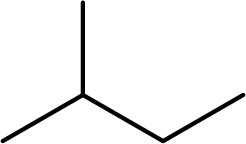
Concept Introduction:
The hydrocarbons which contain only single bonds are said to be
The Alkanes are named following some rules:
- The name of the alkane is given by the number of carbon atoms present in the chain. It is said to be Root of the alkane.
Root = number of carbon atoms in chain.
- To name the root, for one carbon atom, the root name use is meth-. For two carbon atoms, the root name is eth-, for three carbon atoms, it is prop-, for four carbon atoms, it is but-, for five carbon atoms, it is pent- and so on.
- The root name is followed by Suffix. Suffix indicates the functional group present in the compound. It is placed after the root name.
Suffix = name of the functional group present in the compound.
- The root name also contains Prefix. Prefix is the groups attached to the root. It indicates the branched carbon atoms on the root chain and name according to the root specifying the carbon number on which it is placed. It contains –yl in name end. The prefix is placed before the root name.
Prefix = name of the branched carbon atoms on chain.
- The name of the alkane is given in the form
Prefix + Root + Suffix
(a)
Explanation of Solution
The given compound is

To give the compound a systematic name, first the root has to be identified. The root consists of number of carbon atoms present in the longest chain. In the given compound, the longest chain contains four carbon atoms. Hence, the name but- is used as the root. The carbon chain is numbered in the way that the substituents get the lowest number.
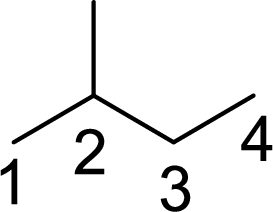
As the given compound contains only single bonds, it is an alkane. For alkanes, the suffix used is –ane. The suffix is added to the root name.
The given compound contains branched carbon atom. It contains one carbon atom (
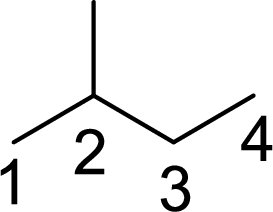
The systematic name of the given compound is
Root = but-
Suffix = -ane
Prefix = 2-methyl-
The name of the given compound is given as 2-methylbutane.
(b)
Interpretation:
The name of the given compound has to be given.

Concept Introduction:
The hydrocarbons which contain only single bonds are said to be cycloalkanes. The general formula for alkanes can be given as
The cycloalkanes are named following some rules:
- The name of the alkane is given by the number of carbon atoms present in the ring. It is said to be Root of the alkane.
Root = number of carbon atoms in ring.
- To name the root, for one carbon atom, the root name use is meth-. For two carbon atoms, the root name is eth-, for three carbon atoms, it is prop-, for four carbon atoms, it is but-, for five carbon atoms, it is pent- and so on.
- The root name is followed by Suffix. Suffix indicates the functional group present in the compound. It is placed after the root name.
Suffix = name of the functional group present in the compound.
- The root name also contains Prefix. Prefix is the groups attached to the root. It indicates the branched carbon atoms on the root chain and name according to the root specifying the carbon number on which it is placed. It contains –yl in name end. The prefix is placed before the root name.
Prefix = name of the branched carbon atoms on chain.
- The name of the alkane is given in the form
Prefix + Root + Suffix
(b)
Explanation of Solution
The given compound is

To give the compound a systematic name, first the root has to be identified. The root consists of number of carbon atoms present in the ring. In the given compound, the ring contains six carbon atoms. Hence, the name hex- is used as the root. The carbon ring is numbered in the way that the substituents get the lowest number.
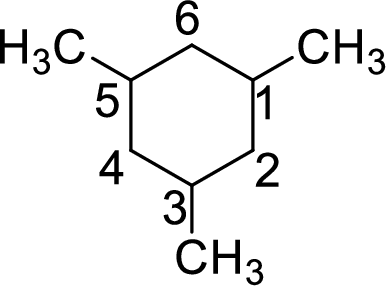
As the given compound contains only single bonds, it is an alkane. For alkanes, the suffix used is –ane. The suffix is added to the root name.
The given compound contains branched carbon atoms. It contains one carbon atom (
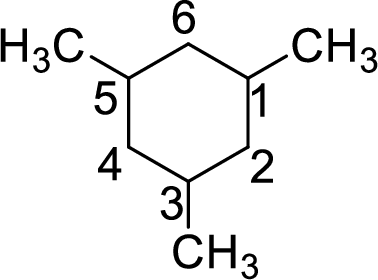
The systematic name of the given compound is
Root = cyclohex-
Suffix = -ane
Prefix = 1,3,5-trimethyl-
The name of the given compound is given as 1,3.5-trimethylcyclohexane.
(c)
Interpretation:
The structure of the given compound (1,2-diethylcyclopentane) has to be drawn.
Concept Introduction:
The structure of the compound is given by its systematic name.
To give the structure from the name of the compound, the root name has to be identified. The root name indicates the number of carbon atoms present in the longest chain.
Then the functional group (suffix) has to be identified. It indicates whether any functional groups are present in the compound, it also gives whether the compound is an alkane or
The prefix of the name indicates the branched groups and their positions on the carbon chain.
The name of the compound is in the form
Prefix + Root + Suffix
(c)
Explanation of Solution
The compound given is 1,2-diethylcyclopentane.
To give the structure of 1,2-diethylcyclopentane, first the root name has to be identified. The root name indicates carbon atoms in ring. In the given compound, the root name is cyclopentane. As the suffix is –ane, it is an alkane and contains only single bonds. Cyclopentane consists of five carbon atoms in ring.
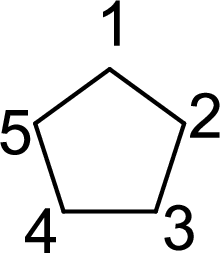
As the name is 1,2-diethylcyclopentane, it contains prefix 1,2-diethyl. The ethyl group contains two carbon atoms (
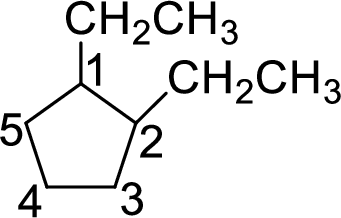
The structure of 1,2-diethylcyclopentane is given as
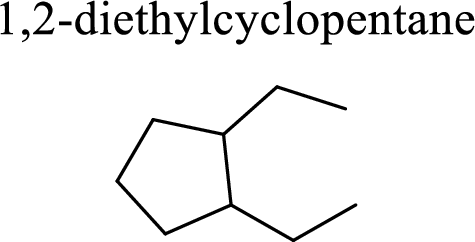
(b)
Interpretation:
The structure of the given compound (2,4,5-trimethylnonane) has to be drawn.
Concept Introduction:
The structure of the compound is given by its systematic name.
To give the structure from the name of the compound, the root name has to be identified. The root name indicates the number of carbon atoms present in the longest chain.
Then the functional group (suffix) has to be identified. It indicates whether any functional groups are present in the compound, it also gives whether the compound is an alkane or alkene or alkyne.
The prefix of the name indicates the branched groups and their positions on the carbon chain.
The name of the compound is in the form
Prefix + Root + Suffix
(b)
Explanation of Solution
The compound given is 2,4,5-trimethylnonane.
To give the structure of 2,4,5-trimethylnonane, first the root name has to be identified. The root name indicates carbon atoms in longest chain. In the given compound, the root name is nonane. In nonane, nine carbon atoms are present in the chain. As the suffix is –ane, it is an alkane and contains only single bonds. The structure of nonane is given as

As the name is 2,4,5-trimethylnonane, it contains prefix 2,4,5-trimethyl. It indicates that the carbon chain is substituted at three positions. The substituent groups are methyl (
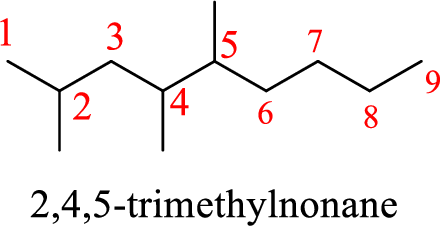
The structure of 2,4,5-trimethylnonane is given as
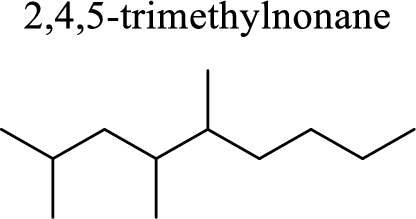
Want to see more full solutions like this?
Chapter 15 Solutions
Chemistry: The Molecular Nature of Matter and Change
 ChemistryChemistryISBN:9781305957404Author:Steven S. Zumdahl, Susan A. Zumdahl, Donald J. DeCostePublisher:Cengage Learning
ChemistryChemistryISBN:9781305957404Author:Steven S. Zumdahl, Susan A. Zumdahl, Donald J. DeCostePublisher:Cengage Learning ChemistryChemistryISBN:9781259911156Author:Raymond Chang Dr., Jason Overby ProfessorPublisher:McGraw-Hill Education
ChemistryChemistryISBN:9781259911156Author:Raymond Chang Dr., Jason Overby ProfessorPublisher:McGraw-Hill Education Principles of Instrumental AnalysisChemistryISBN:9781305577213Author:Douglas A. Skoog, F. James Holler, Stanley R. CrouchPublisher:Cengage Learning
Principles of Instrumental AnalysisChemistryISBN:9781305577213Author:Douglas A. Skoog, F. James Holler, Stanley R. CrouchPublisher:Cengage Learning Organic ChemistryChemistryISBN:9780078021558Author:Janice Gorzynski Smith Dr.Publisher:McGraw-Hill Education
Organic ChemistryChemistryISBN:9780078021558Author:Janice Gorzynski Smith Dr.Publisher:McGraw-Hill Education Chemistry: Principles and ReactionsChemistryISBN:9781305079373Author:William L. Masterton, Cecile N. HurleyPublisher:Cengage Learning
Chemistry: Principles and ReactionsChemistryISBN:9781305079373Author:William L. Masterton, Cecile N. HurleyPublisher:Cengage Learning Elementary Principles of Chemical Processes, Bind...ChemistryISBN:9781118431221Author:Richard M. Felder, Ronald W. Rousseau, Lisa G. BullardPublisher:WILEY
Elementary Principles of Chemical Processes, Bind...ChemistryISBN:9781118431221Author:Richard M. Felder, Ronald W. Rousseau, Lisa G. BullardPublisher:WILEY





